#aihole
Text

Donalds Nephew helps check the oven temperature for Minnie
1 note
·
View note
Photo

Aihole
Aihole (Ayyavole) fue una antigua ciudad amurallada en Karnataka, India central. Fue la primera capital regional de la región de Karnakata bajo el gobierno de los Chalukyas. La gran cantidad de templos y santuarios hindúes primitivos en el sitio datan en su mayoría del siglo VI al VIII, cuando la ciudad estaba en su cenit de prosperidad y poder.
Lire la suite...
1 note
·
View note
Photo

Rich History of Chaukya Dyansty. Badami, Pattadakal and Aihole are three historic places which is in northern Part of Karnataka (Bagalkote District). Badami is around 200 KMs from Hampi which is another must visit place for history lovers. It is believed that Pattadakal is a epicenter of Chalukyan art and architecture. They are known for their rock temples and inscriptions which originated in Aihole around 450 AD and later perfected at Badami and Pattadakal villages. Attracted by the scenic beauty and natural defenses provided by majestically standing hills and vast sheet of water below, the Chalukyas shifted their capital from Aihole to Badami. #chalukyadynasty #Chalukyas #6thcentury #rockcuttemples #badamicaves #badami #aihole #pattadakal #richindia #richcultre #preserve #india #sustainableliving #nehaalmayur (at Badami, Pattadkal, Aihole) https://www.instagram.com/p/CpYluVJSkI2/?igshid=NGJjMDIxMWI=
#chalukyadynasty#chalukyas#6thcentury#rockcuttemples#badamicaves#badami#aihole#pattadakal#richindia#richcultre#preserve#india#sustainableliving#nehaalmayur
0 notes
Text
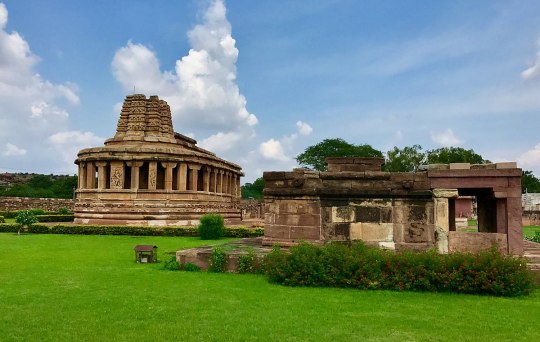
Les temples de Pattadakal sont l’une des attractions historiques uniques de l’Inde, qui sont considérées comme un symbole important de l’architecture indienne ancienne aux 7e et 8e siècles.
Dans la partie sud-ouest de l’État du Karnataka et dans les vallées de la région semi-aride de Bagalkot en Inde, un certain nombre de temples Chalukya ont survécu pendant des siècles, qui sont considérés comme des temples bouddhistes et font partie des temples Patadakal. Le “groupe de monuments de Pattadakal” n’est pas si connu et est considéré comme l’un des sites les moins connus du patrimoine mondial de l’UNESCO. Pour cette raison, cette attraction est considérée comme l’une des destinations insolites et mystérieuses de l’Inde pour les touristes.
#keralabackwatertourpackages#keralahouseboattourpackages#luxurysouthindiatourpackages#temple#aihole#luxury south india tour packages#keralasouthindia#keralaluxury#incredible kerala
0 notes
Text
youtube
#ಗಂಧದಗುಡಿ#ಕರ್ನಾಟಕ#ಚೆಂದದಬೀಡು#ಜೈಕನ್ನಡ#ಜೈಕರ್ನಾಟಕ#ಕನ್ನಡ#about#across#acted#acting#actor#adil#advani#african#after#against#age#ago#aihole#ajmer#akasmika#ali#amalgamation#amont#amritsar#andhra#anil#animal#animals#anniversary
1 note
·
View note
Text

This is the technology I want.
#thank you tumblr#dumb little things that delight me#these little frogs have more soul and meaning than anything produced by the aiholes#i like frogs
6 notes
·
View notes
Text
Best Astrologer in Aihole | Genuine Astrologer in Aihole

Astrology is a science of planets, cosmic and heavenly bodies that influence the good and bad in our lives. Astrology may be a crucial a neighbourhood of our lives as there are things and circumstances that happen in our lives which we don’t have a reason for it.
Want to marry together with your loved one. Get your all dream becoming true with the help of Best Astrologer in Aihole. They will help the people to unravel all the hurdles and make their love marriage. No matters either problem is in marriage life or love life. Now just with the help of astrology your all wishes come true. Many of us take the help of astrology to form their wish come true. Make everyone agree for your marriage. Make every situation possible to your love marriage with the guidance of Guruji.
#Best Astrologer in Aihole#Genuine Astrologer in Aihole#Famous Astrologer in Aihole#Top Astrologer in Aihole#Black Magic & Vashikaran Astrologer in Aihole#Black Magic & Vashikaran Specialist in Aihole#Black Magic & Vashikaran Pandit in Aihole
0 notes
Note
have u ever had anyone accuse u of using ai upon posting your drawings online? i stopped uploading my art because im scared people will call me an aihole just because i'm not the best at drawing hands and at consistent lighting and stuff :(
No bc I take months to finish one sketch and post wips a lot, but I think you're good
I think there's a clear difference between ai art and learning curves
25 notes
·
View notes
Text
Origins of the Pibo: Let’s take a trip along the Silk Road.
1. Introduction to the garment:
Pibo 披帛 refers to a very thin and long shawl worn by women in ancient East Asia approximately between the 5th to 13th centuries CE. Pibo is a modern name and its historical counterpart was pei 帔. But I’ll use pibo as to not confuse it with Ming dynasty’s xiapei 霞帔 and a much shorter shawl worn in ancient times also called pei.
Below is a ceramic representation of the popular pibo.
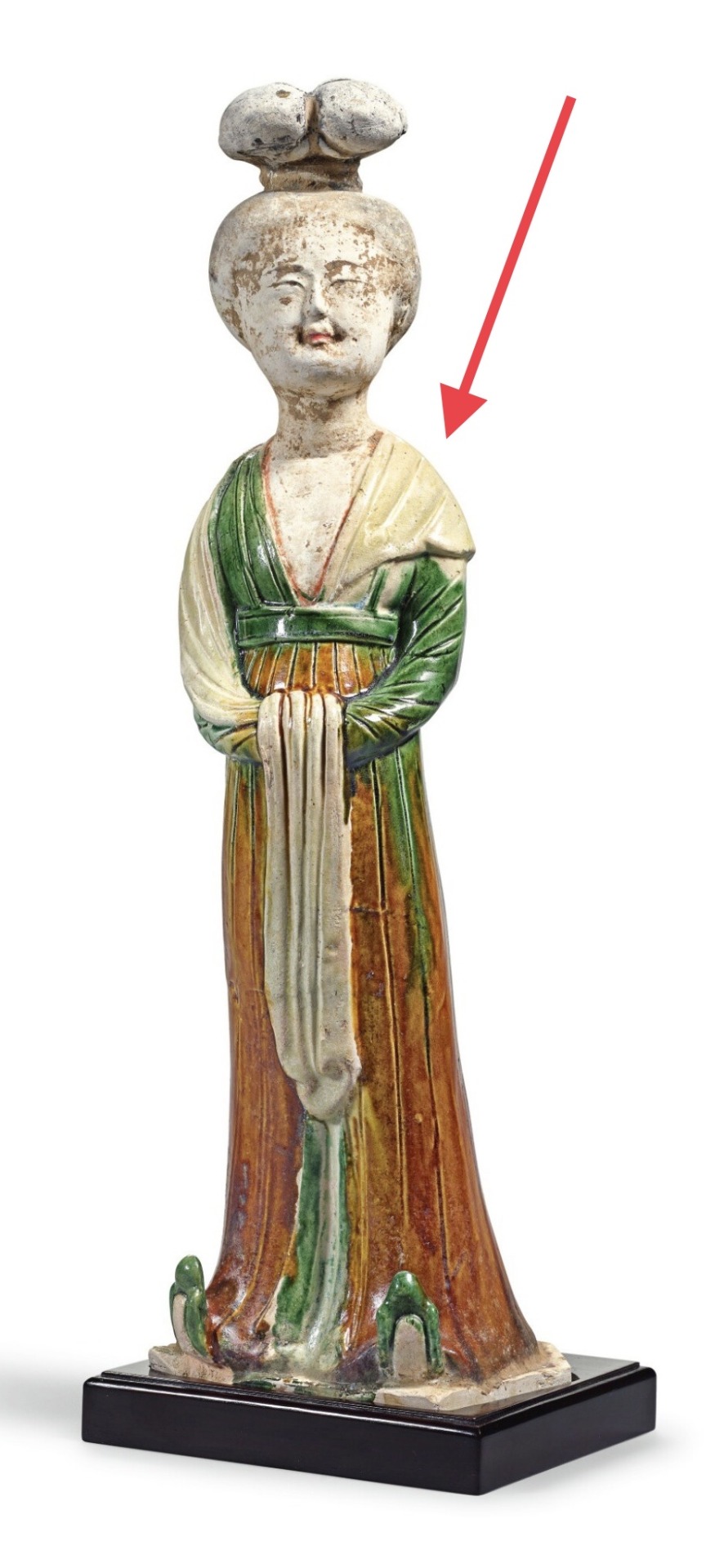
A sancai-glazed figure of a court lady, Tang Dynasty (618–690, 705–907 CE) from the Sze Yuan Tang Collection. Artist unknown. Sotheby’s [image source].
Although some internet sources claim that pibo in China can be traced as far back as the Qin (221-206 BCE) or Han (202 BCE–9 CE; 25–220 CE) dynasties, we don’t start seeing it be depicted as we know it today until the Northern and Southern dynasties period (420-589 CE). This has led to scholars placing pibo’s introduction to East Asia until after Buddhism was introduced in China. Despite the earliest art representations of the long scarf-like shawl coming from the Northern and Southern Dynasties period, the pibo reached its popularity apex in the Tang Dynasty (618–690 CE: 705–907 CE).
Academic consensus: Introduction via the Silk Road.
The definitive academic consensus is that pibo evolved from the dajin 搭巾 (a long and thin scarf) worn by Buddhist icons introduced to China via the Silk Road from West Asia.
披帛是通过丝绸之路传入中国的西亚文化, 与中国服饰发展的内因相结合而流行开来的一种"时世妆" 的形式. 沿丝绸之路所发现的披帛, 反映了丝绸贸易的活跃.
[Trans] Pibo (a long piece of cloth covering the back of the shoulders) was a popular female fashion period accessory introduced to China by West Asian cultures by way of the Silk Road and the development of Chinese costumes. The brocade scarves found along the Silk Road reflect the prosperity of the silk trade that flourished in China's past (Lu & Xu, 2015).
I want to add to the above theory my own speculation that, what the Chinese considered to be dajin, was most likely an ancient Indian garment called uttariya उत्तरीय.
2. Personal conjecture: Uttariya as a tentative origin to pibo.
In India, since Vedic times (1500-500 BCE), we see mentions in records describing women and men wearing a thin scarf-like garment called “uttariya”. It is a precursor of the now famous sari. Although the most famous depiction of uttariya is when it is wrapped around the left arm in a loop, we do have other representations where it is draped over the shoulders and cubital area (reverse of the elbow).
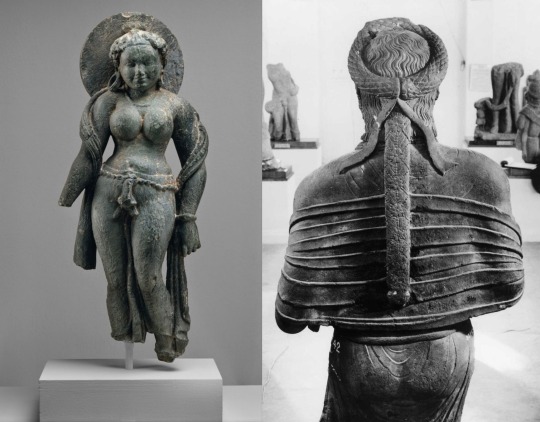
Left: Hindu sculpture “Mother Goddess (Matrika)”, mid 6th century CE, gray schist. Artist unknown. Looted from Rajasthan (Tanesara), India. Photo credit to Metropolitan Museum of Art, New York, United States [image source].
Right: Rear view of female statue possibly representing Kambojika, the Chief Queen of Mahakshatrapa Rajula, ca. 1st century CE. Artist unknown. Found in the Saptarishi Mound, Mathura, India. Government Museum, Mathura [image source].
Buddhism takes many elements from Hindu mythology, including apsaras अप्सरा (water nymphs) and gandharvas गन्धर्व (celestial musicians). The former was translated as feitian 飞天 in China. Hindu deities were depicted wearing clothes similar to what Indian people wore, among which we find uttariya, often portrayed in carvings and sculptures of flying and dancing apsaras or gods to show dynamic movement. Nevertheless, uttariya long predated Buddhism and Hinduism.
Below are carved representation of Indian apsaras and gandharvas. Notice how the uttariya are used.

Upper left: Carved relief of flying celestials (Apsara and Gandharva) in the Chalukyan style, 7th century CE, Chalukyan Dynasty (543-753 CE). Artist Unknown. Aihole, Karnataka, India. National Museum, New Delhi, India [image source]. The Chalukyan art style was very influential in early Chinese Buddhist art.
Upper right: Carved relief of flying celestials (gandharvas) from the 10th to the 12th centuries CE. Artist unknown. Karnataka, India. National Museum, New Delhi, India [image source].
Bottom: A Viyadhara (wisdom-holder; demi-god) couple, ca. 525 CE. Artist unknown. Photo taken by Nomu420 on May 10, 2014. Sondani, Mandsaur, India [image source].
Below are some of the earliest representations of flying apsaras found in the Mogao Caves, Gansu Province, China. An important pilgrimage site along the Silk Road where East and West met.
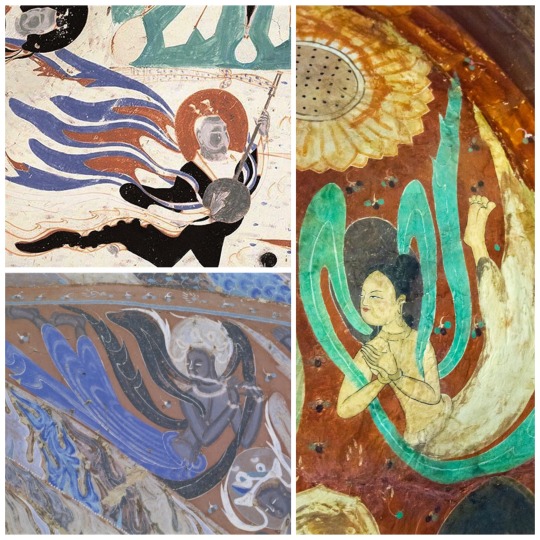
Left to right: Cave No. 461, detail of mural in the roof of the cave depicting either a flying apsara or a celestial musician. Western Wei dynasty (535–556 CE). Artist unknown. Mogao Grottoes, Dunhuang, China [image source].
Cave 285 flying apsara (feitian) in one of the Mogao Caves. Western Wei Dynasty (535–556 CE), Artist unknown. Photo taken by Keren Su for Getty Images. Mogao Grottoes, Dunhuang, China [image source].
Cave 249. Mural painting of feitian playing a flute, Western Wei Dynasty (535-556 CE). Image courtesy by Wang Kefen from The Complete Collection of Dunhuang Grottoes, Vol. 17, Paintings of Dance, The Commercial Press, Hong Kong, 2001, p. 15. Mogao Grottoes, Dunhuang, China [image source].
I theorize that it is likely that the pibo was introduced to China via Buddhism and Buddhist iconography that depicted apsaras (feitian) and other deites wearing uttariya and translated it to dajin.
3. Trickle down fashion: Buddhism’s journey to the East.
However, since Buddhism and its Indian-based fashion spread to West Asia first, to Sassanian Persians and Sogdians, it is likely that, by the time it reached the Han Chinese in the first century CE, it came with Persian and Sogdian influence. Persians’ fashion during the Sassanian Empire (224–651 CE) was influenced by Greeks (hellenization) who also had a a thin long scarf-like garment called an epliblema ἐπίβλημα, often depicted in amphora (vases) of Greek theater scenes and sculptures of deities.

Left to right: Dame Baillehache from Attica, Greece. 3rd century BCE, Hellenistic period (323-30 BCE), terracotta statuette. Photo taken by Hervé Lewandowski. Louvre Museum, Paris, France [image source].
Deatail view of amphora depicting the goddess Artemis by Athenian vase painter, Andokides, ca. 525 BCE, terracotta. Found in Vulci, Italy. Altes Museum, Berlin, Germany [image source].
Statue of a Kore (young girl), ca. 570 BCE, Archaic Period (700-480 BCE), marble. Artist unknown. Uncovered from Attica, Greece. Acropolis Museum, Athens, Greece [image source].
Detail view of Panathenaic (Olympic Games) prize amphora with lid, 363–362 BCE, Attributed to the Painter of the Wedding Procession and signed by Nikodemos, terracotta. Uncovered from Athens, Greece. J. Paul Getty Museum, Los Angeles, California, United States [image source].
Roman statue depicting Euterpe, muse of lyric poetry and music, ca. 2nd century CE, marble, Artist unknown. From the Villa of G. Cassius Longinus near Tivoli, Italy. Photo taken by Egisto Sani on March 12, 2012, Vatican Museums, Rome, Italy [image source].
Greek (or Italic) tomb mural painting from the Tomb of the Diver, ca. 470 BCE, fresco. Artist unknown. Photo taken by Floriano Rescigno. Necropolis of Paestum, Italy [image source].
Below are Iranian and Iraqi period representations of this long thin scarf.

Left to right: Closeup of ewer likely depicting a female dancer from the Sasanian Period (224–651 CE) in ancient Persia , Iran, 6th-7th century CE, silver and gilt. Artist unknown. Mary Harrsch. July 10, 2015. Arthur M. Sackler Gallery of Asian Art, Smithsonian, Washington D.C [image source].
Ewer with nude dancer probably representing a maenad, companion of Dionysus from the Sasanian Period (224–651 CE) in ancient Persia, Iran, 6th-7th century CE, silver and gilt. Artist unknown. Mary Harrsch. July 16, 2015. Arthur M. Sackler Gallery of Asian Art, Smithsonian, Washington D.C [image source].
Painting reconstructing the image of unveiled female dancers depicted in a fresco, Early Abbasid period (750-1258 CE), about 836-839 CE from Jawsaq al-Khaqani, Samarra, Iraq. Museum of Turkish and Islamic Art, Istanbul [image source].
The earliest depictions of Buddha in China, were very similar to West Asian depictions. Ever wonder why Buddha wears a long draped robe similar to a Greek himation (Romans called it toga)?
Take a look below at how much the Greeks influenced the Kushans in their art and fashion. The top left image is one of the earliest depictions of Buddha in China. Note the similarities between it and the Gandhara Buddha on the right.
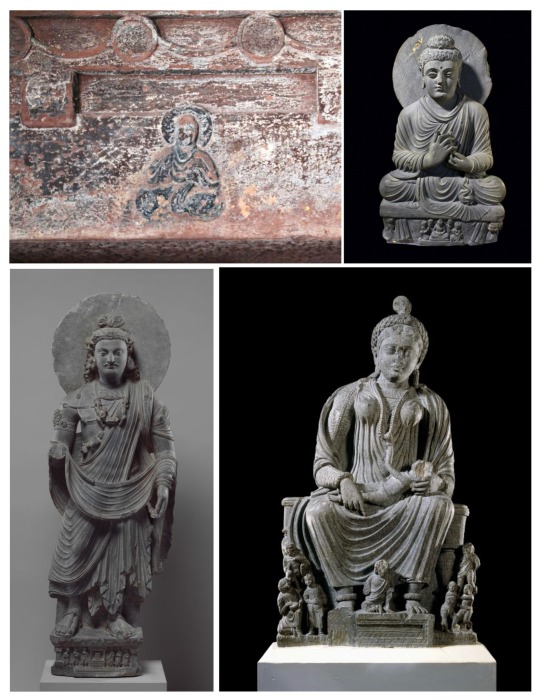
Left: Seated Buddha, Mahao Cliff Tomb, Sichuan Province, Eastern Han Dynasty, late 2nd century C.E. (photo: Gary Todd, CC0).
Right: Seated Buddha from Gandhara, Pakistan c. 2nd–3rd century C.E., Gandhara, schist (© Trustees of the British Museum)
Standing Bodhisattva Maitreya (Buddha of the Future), ca. 3rd century, gray schist. From Gandhara, Pakistan. Image credit to The Metropolitan Museum of Art, New York City, United States [image source].
Statue of seated goddess Hariti with children, ca. 2nd to 3rd centuries CE, schist. Artist unknown. From Gandhara, Pakistan. The British Museum, London, England [image source].
Before Buddhism spread outside of Northern India (birthplace), Indians never portrayed Buddha in human form.
Early Buddhist art is aniconic, meaning the Buddha is not represented in human form. Instead, Buddha is represented using symbols, such as the Bodhi tree (where he attained enlightenment), a wheel (symbolic of Dharma or the Wheel of Law), and a parasol (symbolic of the Buddha’s royal background), just to name a few. […] One of the earliest images [of Buddha in China] is a carving of a seated Buddha wearing a Gandharan-style robe discovered in a tomb dated to the late 2nd century C.E. (Eastern Han) in Sichuan province. Ancient Gandhara (located in present-day Afghanistan, Pakistan, and northwest India) was a major center for the production of Buddhist sculpture under Kushan patronage. The Kushans occupied portions of present-day Afghanistan, Pakistan, and North India from the 1st through the 3rd centuries and were the first to depict the Buddha in human form. Gandharan sculpture combined local Greco-Roman styles with Indian and steppe influences (Chaffin, 2022).
In the Mogao Caves, which contain some of the earliest Buddhist mural paintings in China, we see how initial Chinese Buddhist art depicted Indian fashion as opposed to the later hanfu-inspired garments.

Left to right: Cave 285, detail of wall painting, Western Wei dynasty (535–556 CE). Mogao Grottoes, Dunhuang, China. Courtesy the Dunhuang Academy [image source]. Note the clothes the man is wearing. It looks very similar to a lungi (a long men’s skirt).
Photo of Indian man sitting next to closed store wearing shirt, scarf, lungi and slippers. Paul Prescott. February 20, 2015. Varanasi, India [image source].
Cave 285, mural depiction of worshipping bodhisattvas, 6th century CE, Wei Dynasty (535-556 A.D.), Unknown artist. Mogao Grottoes, Dunhuang, China. Notice the half bow on his hips. That is a common style of tying patka (also known as pataka; cloth sashes) that we see throughout Indian history. Many of early Chinese Buddhist paintings feature it, including the ones at Mogao Caves.
Indian relief of Ashoka wearing dhoti and patka, ca. 1st century BC, Unknown artist. From the Amaravathi village, Guntur district, Andhra Pradesh, India. Currently at the Guimet Museum, Paris [image source].
Cave 263. Mural showing underlying painting, Northern Wei Dynasty (386–535 CE). Artist Unknown. Picture taken November 29, 2011, Mogao Grottoes, Dunhuang, China [image source]. Note the pants that look to be dhoti.
Comparison photo of modern dhoti advertisement from Etsy [image source].
Spread of Buddhism to East Asia.

Map depicting the spread of Buddhism from Northern India to the rest of Asia. Gunawan Kartapranata. January 31, 2014 [image source]. Note how Mahayana Buddhism arrived to China after passing through Kushan, Bactrean, and nomadic steppe lands, absorbing elements of each culture along the way.
Wealthy Buddhist female patrons emulated the fantasy fashion worn by apsaras, specifically, the uttariya/dajin and adopted it as an everyday component of their fashion.

Cave 285. feitian mural painting on the west wall, Western Wei Dynasty (535–556 CE). Artist unknown. Mogao Grottoes, Dunhuang, China [image source].
Cave 285. Detail view of offering bodhisattvas (bodhisattvas making offers to Buddha) next to the phoenix chariot on the Western wall of the cave. Western Wei Dynasty (535–556 CE). Artist unknown. Mogao Grottoes, Dunhuang, China [image source].
Cave 61 Khotanese (from the kingdom of Khotan 于阗 [56–1006 CE]) donor ladies, ca. 10th century CE, Five Dynasties period (907 to 979 CE). Artist unknown. Picture scanned from Zhang Weiwen’s Les oeuvres remarquables de l'art de Dunhuang, 2007, p. 128. Uploaded to Wikimedia Commons on October 11, 2012 by Ismoon. Mogao Grottoes, Dunhuang, China [image source].
Detail view of Ladies Adorning Their Hair with Flowers 簪花仕女图, late 8th to early 9th century CE, handscroll, ink and color on silk, Zhou Fang 周昉 (730-800 AD). Liaoning Provincial Museum, Shenyang, China [image source].
Therefore, the theory I propose of how the pibo entered East Asia is:
India —> Greek influenced West Asia (Sassanian Persians, Sogdians, Kushans, etc…) —> Han China —> Rest of East Asia (Three Kingdoms Korea, Asuka Japan, etc…)
Thus, the most likely theory, in my person opinion, is Buddhist iconography depicting uttariya encountered Greek-influenced West Asian Persian, Sogdian, and Kushan shawls, which combined arrived to China but wouldn’t become commonplace there until the explosion in popularity of Buddhism from the periods of Northern and Southern Dynasties to Song.
References:
盧秀文; 徐會貞. 《披帛與絲路文化交流》 [The brocade scarf and the cultural exchanges along the Silk Road]. 敦煌研究 (中國: 敦煌研究編輯部). 2015-06: 22 – 29. ISSN 1000-4106.
#hanfu#chinese culture#chinese history#buddhism#persian#sogdian#kushan#gandhara#indian fashion#uttariya#pibo#history#asian culture#asian art#asian history#asian fashion#east asia#south asia#india#pakistan#iraq#afghanistan#sassanian#silk road#fashion history#tang dynasty#eastern han dynasty#cultural exchange#greek fashion#mogao caves
297 notes
·
View notes
Text




Xanadu The Lego Playset
1 note
·
View note
Text



Nimbus
Looks extra angelic with angel wings!
Inspired by Lohia Aihol's "Forbidden".

Head: Angelic CIrclet - snow white
Body: YoRHa Type-51 Robe of Casting - pastel purple
Hands: Ascension Gloves of Casting - pastel purple
Legs: Quan - iris purple
Feet: Bridesmaid's Sandals - iris purple
Earring: The Emperor's New Earrings
Neck: The Emperor's New Necklace
Wrists: The Emperor's New Bracelet
Right Ring: The Emperor's New Ring
Left Ring: The Emperor's New Ring
Main Hand: Edengrace Rod - pastel purple
Off Hand: --
Fashion Accessory: Angel Wings
Minion: --
Mount: --
Location: Eden's Gate: Sepulture
Shader: Faeberry Bloom
#ffxiv#ffxiv glamour#ffxiv au ra#ffxiv black mage#eorzea collection#valkariel ilmarë#au ra#raen#black mage#casters#purples/violets#lights/whites/pastels#uses mogstation items#no seasonal items#fantasy glamour#divine glamour#inspired by other glam
24 notes
·
View notes
Photo


Imagine being Oropher's lover and Thranduil being jealous of your relationship, because he loves you, too.
Author: @thatkgrl
Artist: Aiholic
#thranduil#oropher#thranduil imagines#oropher imagines#imagines#elf imagines#elves#mirkwood elves#the silmarillion
51 notes
·
View notes
Text
Divine Odyssey: Exploring Karnataka's Temples
This country boasts breathtaking landscape and a rich culture, inviting travelers from all over the world with its wonderful temples. These temples are not just shrines but architectural stories depicting the glory of the state, art, and religion. Join us on a religious journey as we visit some of the famous temples in Karnataka and unveil the mystical texture that is embedded in this southern pearl.

The Temples of Belur and Halebidu
Our journey begins with the charming twin towns of Belur and Halebidu. Here, you'll encounter the stunning Chennakeshava Temple in Belur and the Hoysaleswara Temple in Halebidu. These temples are examples of Hoysala architecture, known for their intricate stone carvings that adorn every inch of the structures. The stories etched in stone narrate mythological tales, leaving visitors in awe of the craftsmanship and devotion that went into their creation.
The Magnificent Mysore Palace
Visiting Mysore Palace is not a complete cultural heritage exploration in Karnataka. Despite not being a temple in the real sense, the magnificent structure is an indication of a blend of Indo-Saracenic, Rajput, and Dravidian architectural styles. Special occasions will make you seem to be in a fairy-tale where the lavishness of the palace and magnificently lit facade.
The Spiritual Hub of Srirangapatna
Srirangapatna, a small island town on the Cauvery River, is home to the Sri Ranganathaswamy Temple. This temple complex is dedicated to Lord Ranganatha, a form of Lord Vishnu. Its intricate architecture and serene surroundings make it a peaceful retreat for pilgrims and karnataka tour itinerary alike. While in Srirangapatna, you can also pay your respects at the Gumbaz, the mausoleum of Tipu Sultan and his parents.
Udupi - The Abode of Lord Krishna
Udupi is synonymous with Lord Krishna, and the Udupi Krishna Temple is a place of immense significance for devotees. The temple follows a unique tradition in which Lord Krishna is worshiped through a silver-plated window. The temple complex also houses a serene garden and a dining hall that serves delectable vegetarian meals, a tradition that has continued for centuries.
Badami, Aihole, and Pattadakal
For aficionados of history and architecture, the karnataka temple tour complexes of Badami, Aihole, and Pattadakal are a treasure trove. These sites showcase a blend of Dravidian and Nagara architectural styles. Explore rock-cut caves, intricately carved temples, and monolithic sculptures, all amidst stunning rock formations and tranquil surroundings.
Hampi - The City of Ruins and Temples
Hampi, a UNESCO world heritage site, which is still standing and an indication of the grandeur of the Vijayanagara Empire. In the center of the city lies the famous Virupaksha shrine, dedicated to Lord Shiva. Hampi’s spectacular ruins, lively markets, and peaceful Tungabhadra river provide a sense of traveling to the past.
The Historic Kollur Mookambika Temple
Situated in the dense forests of the Western Ghats, the Kollur Mookambika Temple is a place of deep reverence. The deity, Goddess Mookambika, is believed to be an embodiment of the divine feminine energy. The temple's tranquil ambiance and lush surroundings make it a perfect place for spiritual reflection.

In Conclusion
Temples in Karnataka are not only religious places of worship but also living embodiments of Karnataka’s strong culture and architectural heritage. However, a divine odyssey across these temples takes you into a realm of art, history, and spirituality. In the process of looking at the treasures, you will discover the aesthetics of the land but also the spirit that has prevailed in it for long. It is a journey which inscribed on the soul and a memory to be kept forever.
2 notes
·
View notes
Text
Interesting Facts about Karnataka | ಕನ್ನಡ ನಾಡು | One State Many Worlds | ಗಂಧದ ಗುಡಿ | ಜೈ ಕರ್ನಾಟಕ
https://youtu.be/pRQ9mZwXXY8
(Please Subscribe!)
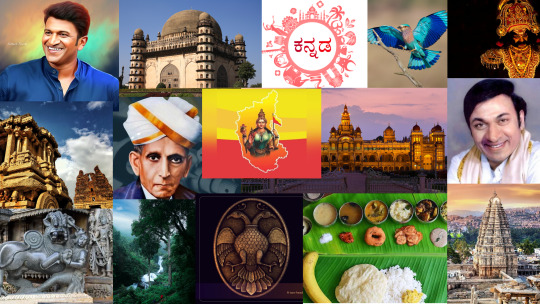
#ಗಂಧದಗುಡಿ#ಕರ್ನಾಟಕ#ಚೆಂದದಬೀಡು#ಜೈಕನ್ನಡ#ಜೈಕರ್ನಾಟಕ#ಕನ್ನಡ#about#across#acted#acting#actor#adil#advani#african#after#against#age#ago#aihole#ajmer#akasmika#ali#amalgamation#amont#amritsar#andhra#anil#animal#animals#anniversary
0 notes
Text
Discover Hidden Gems: Secret Spots to Explore in Karnataka

Karnataka, with its rich tapestry of culture and natural splendor, is a treasure trove of hidden gems just waiting to be uncovered by intrepid travelers. If you're ready to stray from the usual routes and dive into the state's lesser-known wonders, here’s a guide to some of Karnataka’s most enchanting secret spots.
Gokarna
Perched along Karnataka’s serene coastline, Gokarna is a tranquil beach town that goes beyond its famed beaches like Om Beach and Kudle Beach. Venture off the beaten path to discover hidden coves, embark on scenic hikes to secluded viewpoints, and experience breathtaking sunsets over the Arabian Sea. This place is not only a haven for beach lovers but also a retreat for those seeking spiritual solace.
Chikmagalur
Nestled in the Western Ghats, Chikmagalur is a charming hill station celebrated for its verdant coffee plantations and mist-shrouded hills. Uncover its secrets by visiting the lesser-known Jhari Waterfalls and Hebbe Falls, trek through dense forests to the peak of Mullayanagiri, Karnataka’s highest mountain, and explore the ancient caves of Baba Budangiri for a serene escape into nature.
Hampi
Step into the ancient world of Hampi, a UNESCO World Heritage Site where historical grandeur meets stunning landscapes along the Tungabhadra River. Beyond the well-trodden ruins, seek out the quiet beauty of Virupapura Gadde island, marvel at the intricacies of rock-cut temples, and immerse yourself in the local culture of the riverside village of Anegundi.
Agumbe
Often referred to as the "Cherrapunji of the South," Agumbe is a verdant paradise in the Western Ghats renowned for its lush rainforests and rich biodiversity. Trek to the awe-inspiring Barkana Falls, visit the Agumbe Rainforest Research Station to learn about the region’s unique ecosystems, and embark on a wildlife safari to spot rare species in their natural habitat.
Badami
Journey back to ancient times in Badami, a town renowned for its stunning sandstone cliffs and rock-cut cave temples from the 6th century. Discover the hidden cave temples of Badami, explore the UNESCO World Heritage Site of Pattadakal with its exquisitely carved temples, and be amazed by the ancient architectural wonders of Aihole.
Coorg (Kodagu)
Find solace in the misty hills of Coorg, or Kodagu, known for its lush coffee and spice plantations. Seek out secret viewpoints like Mandalpatti for sweeping views of the Western Ghats, trek through the verdant Pushpagiri Wildlife Sanctuary, and relax by the tranquil Chelavara Falls for a refreshing retreat.
Karwar
Experience the untouched charm of Karwar, a coastal town blessed with unspoiled beaches, backwaters, and verdant hills. Discover hidden treasures like Devbagh Beach and Majali Beach, go island-hopping to Kurumgad and Devbagh Islands, and enjoy water sports or leisurely boat rides along the serene Kali River Estuary.
Conclusion
Karnataka’s hidden gems are a rich blend of natural beauty, historical depth, and cultural allure. Whether you're drawn to secluded beaches, ancient ruins, tranquil hill stations, or lush rainforests, these secret spots promise an unforgettable adventure off the beaten path.
READ MORE
0 notes
Text
Journey Through Opulence: Deccan Odyssey’s Luxury Train Route
Embark on an extraordinary adventure with the Deccan Odyssey luxury train route, a journey that seamlessly blends comfort, opulence, and the rich cultural tapestry of India’s Deccan region. From the moment you step aboard, the Deccan Odyssey route promises an unparalleled experience filled with royal treatment and exquisite amenities, ensuring a memorable voyage through some of India’s most captivating destinations.

The Deccan Odyssey Experience
The Deccan Odyssey luxury train route is synonymous with elegance and grandeur. The train’s interiors are designed to reflect the splendor of Indian royalty, with plush furnishings, intricate decor, and state-of-the-art facilities. As you traverse the Deccan Odyssey route, you will find yourself immersed in an atmosphere of luxury and sophistication.
Dining and Cuisine

Dining aboard the Deccan Odyssey luxury train route is an exquisite culinary journey. Guests are treated to a variety of gourmet cuisines, both Indian and international, prepared by expert chefs. Each meal on the Deccan Odyssey route is a celebration of flavors, using the finest ingredients to create dishes that tantalize the taste buds. From regional specialties to international favorites, the dining experience is designed to delight and satisfy.
Route Highlights
Mumbai

The journey along the Deccan Odyssey luxury train route begins in Mumbai, the vibrant financial capital of India. Known for its bustling streets and iconic landmarks, Mumbai is the perfect starting point for this luxurious journey. As you explore the Deccan Odyssey route, you’ll visit the Gateway of India, stroll along Marine Drive, and experience the lively local markets, setting the stage for an unforgettable adventure.
Nashik

Next on the Deccan Odyssey route is Nashik, a city renowned for its spiritual significance and burgeoning wine industry. Here, you can visit ancient temples and partake in wine tasting sessions at some of the country’s finest vineyards. The Deccan Odyssey luxury train route offers a unique opportunity to explore Nashik’s rich heritage and modern attractions.
Aurangabad

Aurangabad, a highlight of the Deccan Odyssey luxury train route, is a city steeped in history and architecture. The star attractions here are the Ajanta and Ellora Caves, UNESCO World Heritage Sites known for their intricate rock-cut architecture and ancient frescoes. As you journey along the Deccan Odyssey route, you’ll marvel at these ancient wonders and the stories they tell.
Bijapur

In Bijapur, the Deccan Odyssey route takes you to a city famed for its impressive architectural heritage. The Gol Gumbaz, with its massive dome, and the beautifully adorned Ibrahim Rauza are must-visit sites that reflect Bijapur’s rich historical past. The Deccan Odyssey luxury train route provides an in-depth look at these magnificent structures.
Aihole and Pattadakal

Aihole and Pattadakal are celebrated stops on the Deccan Odyssey luxury train route. These UNESCO World Heritage Sites are known for their stunning temple architecture. As you explore the Deccan Odyssey route, you’ll discover the early Chalukyan architecture and intricately carved temples that date back centuries, offering a glimpse into India’s ancient past.
Hampi

Hampi, a jewel on the Deccan Odyssey route, was once the capital of the Vijayanagara Empire. This sprawling site of ruins and temples includes the Virupaksha Temple, the iconic stone chariot at Vittala Temple, and the royal enclosures. The Deccan Odyssey luxury train route allows you to immerse yourself in the grandeur of this ancient city.
Hyderabad

Hyderabad, the city of pearls, is a vibrant stop on the Deccan Odyssey luxury train route. Known for its rich cultural heritage and bustling bazaars, Hyderabad offers travelers a chance to explore the historic Charminar, visit the majestic Golconda Fort, and shop for unique pearls and traditional crafts at local markets. The Deccan Odyssey route ensures a comprehensive experience of this dynamic city.
On-Board Activities
The Deccan Odyssey luxury train route ensures that the journey is as engaging as the destinations themselves. Onboard activities include cultural programs, interactive sessions with historians, and traditional music and dance performances. As you travel along the Deccan Odyssey route, you can also unwind at the onboard spa, which offers a range of rejuvenating treatments.
Spa and Wellness

The train’s spa and wellness facilities provide the perfect opportunity to relax and rejuvenate. Passengers on the Deccan Odyssey luxury train route can enjoy massages, facials, and other treatments designed to enhance their travel experience, ensuring they arrive at each destination refreshed and invigorated.
Accommodation
The Deccan Odyssey luxury train route offers a range of luxurious accommodations, each designed to provide maximum comfort and privacy. The cabins are elegantly furnished, featuring modern amenities and personalized services to ensure a comfortable stay as you traverse the Deccan Odyssey route.
Cabin Categories
There are various cabin categories to choose from, including deluxe cabins and presidential suites. Each cabin on the Deccan Odyssey luxury train route is equipped with state-of-the-art facilities, ensuring that passengers travel in style and comfort. The personalized services and attention to detail make the Deccan Odyssey route a truly luxurious experience.
Conclusion
The Deccan Odyssey luxury train route is a journey of a lifetime, offering an opulent travel experience through India’s most captivating regions. From the bustling streets of Mumbai to the ancient ruins of Hampi, this journey is a celebration of India’s rich heritage and unparalleled luxury. Embark on this remarkable journey and discover the magic of the Deccan Odyssey route
0 notes